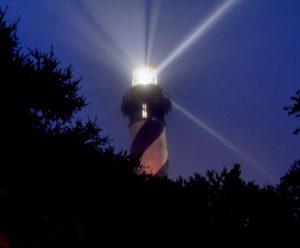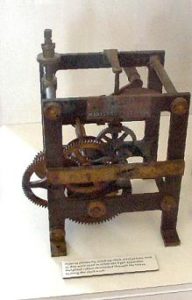This next installment in our series on lighthouse technology focuses on the clockwork mechanisms that rotate Fresnel lens, giving lighthouses their distinctive flashing patterns.
Click the link below to read previous post in the series:
Light Characteristic
Lighthouses are equipped with unique  light characteristic or flashing pattern that sailors can use to identify specific lighthouses during the night. Lighthouses can achieve distinctive light characteristics a few different ways. A lighthouse can flash, which is when brief periods of light interrupt longer moments of darkness. The light can occult, which is when brief periods of darkness interrupt longer moments of light. The light can be fixed, which is when the light never goes dark. A lighthouse can use a combination of flashing, occulting, or being fixed in a variety of combinations and intervals to create an individual light characteristics.
light characteristic or flashing pattern that sailors can use to identify specific lighthouses during the night. Lighthouses can achieve distinctive light characteristics a few different ways. A lighthouse can flash, which is when brief periods of light interrupt longer moments of darkness. The light can occult, which is when brief periods of darkness interrupt longer moments of light. The light can be fixed, which is when the light never goes dark. A lighthouse can use a combination of flashing, occulting, or being fixed in a variety of combinations and intervals to create an individual light characteristics.
It is a common misconception that a lighthouse’s light source changes intensity to create a light characteristic. The light source actually remains constant and the rotating Fresnel lens creates the various changes in appearance. Some Fresnel lenses have “bulls-eye” panels create beams of light that, when rotated between the light and the observer, make the light appear to flash. Conversely, some lenses have metal panels that, when rotated between the light and the observer, make the light appear to go dark.
Clockwork Mechanism

This clockwork mechanism, on display at the Bodie Island Lighthouse, is very similar to the one used in the St. Augustine Lighthouse.
Today the St. Augustine Lighthouse uses a quarter-horsepower electric motor to turn its first-order Fresnel lens and create its distinctive light characteristic. Before the introduction of electricity, the lighthouse had a clockwork mechanism that caused the lens to rotate. The mechanism consisted of a large 275-pound weight attached by a cable through the center of the lighthouse to the top where the cable wrapped around a barrel or drum. The keeper would crank the clockwork mechanism, which would lift the weight by wrapping the cable further around the barrel.
Once the weight lifted to its apex at the bottom of the first landing, the keeper would let the weight fall, which would pull on the cable, which would in turn rotate the barrel. A series of gears took the rotation of the barrel and transferred it to the Fresnel lens, which would then rotate to create the lighthouse’s unique light characteristic. Creating a specific characteristic required a way to regulate the speed of the rotation, hence the clockwork part of the mechanism. The weight had to fall at a certain rate to create the proper rotation speed of the lens and a regulator accomplished this. The weight reached the bottom of the tower every two and a half hours, making the keepers return to the top of the lighthouse to rewind the mechanism several times during the night.
When the St. Augustine Lighthouse first exhibited its light on October 15, 1874, the lens completed a full rotation once every nine minutes. With three bulls-eye panels placed equidistant from one another on the lens, this created a flash every three minutes. The rest of the lens panels were clear band lenses so the lighthouse’s characteristic was fixed (because it did not occult) with a flash every 3 minutes.
A newspaper article from the St. Augustine Record on the occasion of the lighthouse’s electrification in 1936 states that the keepers were able to increase the rotation speed of the lens to one rotation every three minutes with the new electric motor, which would create a flash every minute. Either the writer was misinformed or the keepers were later instructed to increase the rotation speed because further research shows that this did not last long. The 1937 Light List shows the St. Augustine Lighthouse as exhibiting a flash every 30 seconds, the same as it is today.
Stay tuned for the next installment in our lighthouse technology series, where we will discuss the kinds of lighting sources used to illuminate the St. Augustine Lighthouse over its history.
Our Fresnel lens is still turning, sending its light 20 miles out to sea. Come visit the lighthouse and see our historic lens at the top of the tower.
Paul Zielinski is Director of Interpretation for the St. Augustine Lighthouse & Museum. He received his master’s degree in Public History from the University of West Florida and joined the lighthouse family in 2011.

